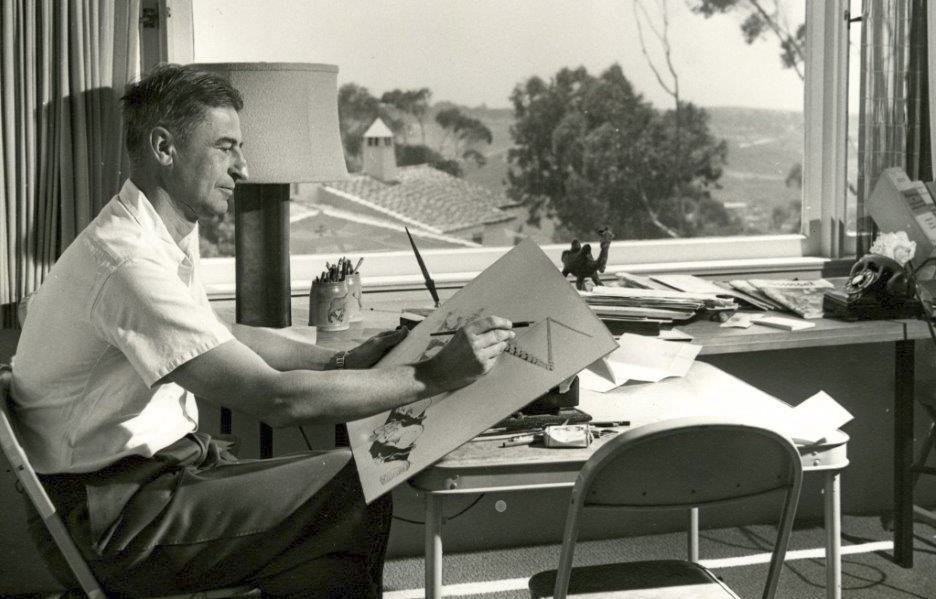Throughout the 1930s and 1940s, he worked variously as a cartoonist for magazines such as Vanity Fair and Life, or as an advertising artist for companies that included Standard Oil and General Electric. But Ted Geisel envisioned using his talents in an entirely different way.

Ted was born on March 2, 1904, in Springfield, Massachusetts. He was the grandson of German immigrants. Ted’s father managed the family brewery, and had it not been for Prohibition during the 1920s, the creative young man might have ended up making good German beer. But instead, after the brewery was forced to close, Ted enrolled at the University of Oxford, studied art, and became a successful illustrator. Despite this success, however, Ted wanted to write books.
In 1936, while returning from an ocean voyage to Europe, Ted got the idea for a children’s book. He made notes and composed lines of verse while standing at the ship’s rail. After arriving back home in New York City, he spent the next six months writing and illustrating his first book — and rewriting it; and sweating over every little detail of the words and pictures.

When he finished A Story That No One Can Beat, he tucked the original manuscript beneath his arm and started making the rounds at all the major publishing houses. From 1936 through much of 1937, Ted showed his illustrated story to 27 different book editors — none of whom apparently felt it was A Story That No One Can Beat. All 27 rejected Ted’s book. And they all gave essentially the same reasons: your book is “too different” from other children’s material; fantasy doesn’t sell these days; and worst of all, a story told in verse is simply out of vogue! The editors also complained that Ted’s book contained “no moral or message,” and they didn’t care to publish anything NOT written with the aim of “transforming children into good citizens.”
Ted repeatedly argued, “What’s wrong with kids having fun reading without being preached to?” His words, though, fell upon deaf ears.
After his 27th rejection, Ted tucked his tattered manuscript beneath his arm once again, and headed home. Depressed, frustrated, and more than just a little angry, he intended to burn the book when he reached his apartment. But along the way, he bumped into an old friend. The man asked him, “What’s that under your arm?”
“…A book that no one wants to publish,” came the answer. “I’m lugging it home to burn.”
 Ted’s friend explained that not three hours earlier he’d been made an editor at Vanguard Press. In fact, he said, “We’re standing outside my new office.” He then invited Ted up to his office so he could look over the manuscript. Once inside, the man introduced Ted to the children’s book editor, who almost immediately agreed to publish the book, but with a single stipulation: “…You’ve got to give me a snappier title!”
Ted’s friend explained that not three hours earlier he’d been made an editor at Vanguard Press. In fact, he said, “We’re standing outside my new office.” He then invited Ted up to his office so he could look over the manuscript. Once inside, the man introduced Ted to the children’s book editor, who almost immediately agreed to publish the book, but with a single stipulation: “…You’ve got to give me a snappier title!”
Vanguard Press published Ted’s first children’s book, retitled And to Think I Saw It on Mulberry Street, in 1937, with an impressive print run of 15,000 copies. The book received glowing reviews, and it sold reasonably well. But after six years, and a couple of reprints, the book had only sold about 30,000 copies. Ted had earned less than $3,500 in royalties, so Mulberry hadn’t exactly made the author rich.

No matter, Ted was on his way. He continued to create children’s books. He also continued to write and illustrate them under the pseudonym of Dr. Seuss! His later books include The Cat in the Hat and How the Grinch Stole Christmas. Today, several decades later, most of these books are still in print, with sales now totaling over 600 million copies. Several have been adapted as animated TV specials, and How the Grinch Stole Christmas has been made into two big-budget movies, both of which were incredibly successful at the box office!
A “chance” meeting with a man who was willing to lend a helping hand had put Theodore Geisel on the road to success. Geisel once wrote of that
encounter, “If I had been going down the other side of Madison Avenue, I’d be in the dry-cleaning business today.” What a sobering thought! Imagine a world without Dr. Seuss or Green Eggs and Ham !! Thank God for “chance” meetings and kind souls everywhere, who are willing to facilitate worthy endeavors!
“The LORD directs the steps of the godly. He delights in every detail of their lives.” (Psalm 37:23 NLT)
